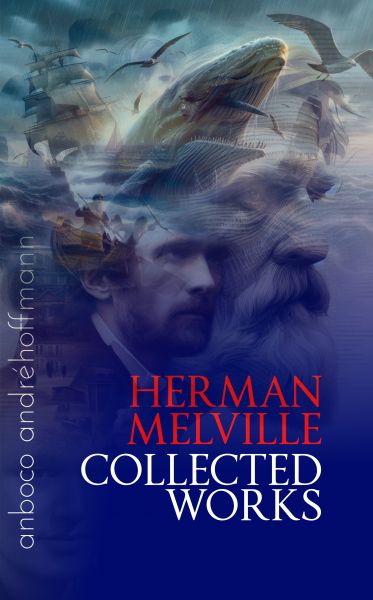Herman Melville Collected Works
anboco
Embark on a literary voyage with Hermann Melville, the scribe of the seas, whose pen charted the depths of the human condition. His masterwork, "Moby-Dick," is not merely a tale but an odyssey that grips the soul and plunges you into the tumultuous waters of obsession and the unknown. Rediscover the Classics: "Moby-Dick": A battle against the unfathomable, a journey that will anchor in your memory, "Bartleby, the Scrivener": A narrative of defiance against life's drudgery, "Billy Budd": A profound drama of innocence and justice on the high seas. This e-book presents the works of this famous and brilliant writer: - Moby Dick; Or, The Whale - Bartleby, the Scrivener: A Story of Wall-Street - Billy Budd, Foretopman - The Piazza Tales - The Confidence-Man: His Masquerade - Typee: A Romance of the South Seas - Battle-Pieces and Aspects of the War - Pierre; or The Ambiguities - Omoo: Adventures in the South Seas - Redburn -The Apple-Tree Table, and Other Sketches - The Chase - Typee - I and My Chimney - Mardi: and A Voyage Thither - Israel Potter - John Marr and Other Poems - I and my Chimney - Typee - Omoo: Adventures in the South Seas - Sea Pieces - Poems From Timoleon - White Jacket; Or, The World on a Man-of-War etc. Melville's works are essential for every bibliophile. His works offer profound insights and timeless themes, wrapped in captivating storytelling. Prepare for a reading experience that will challenge and inspire you. Read Melville – unleash your imagination.
Herman Melville (1819 - 1891) - American writer, poet and essayist: Melville's first novel, Typee, is about the journey of two deserters through the South Seas. The adventure novel met the taste of the time, despite its criticism of colonialism and its unreserved portrayal of the indigenous peoples. The royalties from the subsequent novel Omoo eventually enabled him to marry Elizabeth Shaw. The novel Mardi and a Journey There was published in 1847. Melville himself saw his third work as the turning point in his work. Following the escape of two sailors, the South Sea adventure develops into a journey of the soul and cosmogony and ends in an allegorical satire in which he caricatures the futility of the nation-state's striving for power. The numerous discourses, the accumulation of descriptions, the rich linguistic and stylistic variation as well as the depiction of mental and physical processes, which show the hopelessness and absurdity but also the tragedy of the protagonist, allow the totality of the epic to reappear in the modern novel.
In the two works that followed, Redburn and Whitejacket or the World on a Warship, Melville chose the ship as a microcosm. Although he later devalued both works due to their supposed lack of linguistic power, not least because of their lower density of innovation compared to the previous novel, they can be read as an intensification and streamlining of their predecessor. In contrast to Mardi, the main characters are not merely drawn as allegories or representatives of ideas, but are tangible as characters, and in the white jacket of the nameless sailor, Melville for the first time captures the symbol of nothingness, as later in the whale Moby Dick. As maritime novels, they are among the author's most accessible works due to their realism. In his novel Moby-Dick or the White Whale, he wrote the tragic epic of the anti-hero Ahab in the fable of a whale hunt, who chooses to perish in search of revenge on the man who caused his severed lower leg. The novel is one of the most important works of American literature and, due to its formal and stylistic innovations, is cited as a precursor to numerous novels of classical modernism that were only published in the 20th century. The novel is one of the most important works of world literature.
Mardi and Moby Dick again failed to achieve financial success. This was not least a reaction to his narrative idiosyncrasy and audacious choice of subject - the subsequent marriage novel Pierre or the Ambiguities deals with sibling incest - although his stories, which appeared in 1856 under the title The Piazza Tales, were praised by contemporaries as literary achievements. The six stories, including The Piazza, Bartleby the Scribe, Benito Cereno and The Encantadas, once again show Melville to be a great innovator of American prose and an outstanding representative of world literature. Melville's last novel, The Confidence-Man, was published in 1857. The former seafarer had to work as a customs officer in New York harbor until his retirement due to his low income.
Late in life, he wrote his first volume of poetry. This was followed by the verse epic Clarel and the poetry collection John Marr and Other Sailors. His last work, the posthumously published novella Billy Budd, achieved worldwide fame. Melville's poetry, which, like his middle and late novels, is oriented towards the poetic theorem of blackness, heroism in the modern age and the totality of the epic and deals with borderline areas of the soul such as pain, delusion, suffering and the desire for redemption, is classified as hermeticism.
Versandkostenfreie Lieferung! (eBook-Download)
Als Sofort-Download verfügbar
- Artikel-Nr.: SW9783736404083110164
- Artikelnummer SW9783736404083110164
-
Autor
Herman Melville
- Mit André Hoffmann
- Wasserzeichen ja
- Verlag anboco
- Seitenzahl 9800
- Veröffentlichung 01.08.2024
- ISBN 9783736404083
- Mit André Hoffmann

